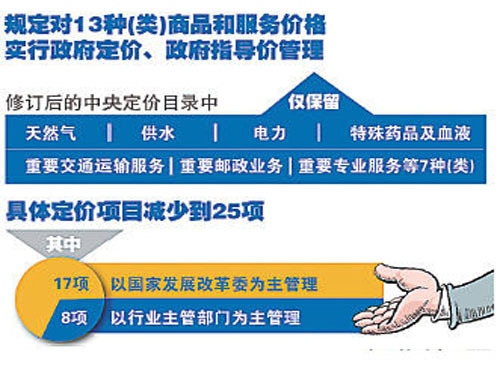
Yesterday (May 6th), the National Development and Reform Commission publicly solicited opinions on the “Central Pricing Catalog†(Consultation Draft) (hereinafter referred to as the “Consideration Draftâ€) through the website of the Chinese Government Legal Information Network and the National Development and Reform Commission.
It is understood that the catalogue was formed on the basis of the "State Pricing Planning Commission and the Pricing Catalogue of the State Council Related Departments" in 2001. The "negative list" management method was adopted and included in the list. The government can formulate government pricing or government guidance (setting the benchmark Price and float). For those who are not included in the list, the operators can set their own prices, and the market can determine the prices through competition. The government can not make improper interventions.
Compared with the old catalogue, the pricing category of the “Opportunities†released this time was reduced by approximately 46%, and the specific projects were significantly reduced by 80%.
However, the salt prices that have attracted much attention have not appeared in the catalogue, but will be based on the progress of the salt industry reform process and the level of competition in the market “just in timeâ€.
Hong Tao, director of the Institute of Business Economics at Beijing Technology and Business University, told an interview with the reporter of “Daily Economic News†that in China, prices of more than 96% of goods and services are determined by the market, and the price system has a higher level of marketization. Government pricing is not a matter of releasing as much as possible, but it should be determined based on the attributes of the product itself and the market competition.
Central pricing only retains 7 kinds
“This is a milestone for the depreciation of the price by the price department.†Xu Kunlin, director of the price division of the National Development and Reform Commission, commented.
The Catalogue for the Pricing of State Planning Commissions and Departments of the State Council, published in 2001, stipulates that the price of 13 kinds of goods and services shall be regulated by the government.
For more than a decade, with the deepening of price reforms, the prices of important goods and services such as central reserve materials, fertilizers, and telecommunications basic services have been formed by the market. Currently, the prices actually managed by the central government are 10 (categories).
Since then, the National Development and Reform Commission has successively liberalized the prices of 60 commodities and services. From June 1 this year, the vast majority of drugs will also bid farewell to government pricing, and will expand the government's “report card†to 61 items.
In this release of the Opinions, the basic central reserve materials, tobacco leaves, civil explosives equipment, chemical fertilizers, teaching materials, military products, and telecommunications that originally belonged to the central pricing category were all withdrawn from the central pricing catalog, and medicines, transportation, and important professional services. There are also a considerable number of varieties that are no longer priced by the central government.
The central pricing categories that have been retained include seven kinds of natural gas, water supply, electricity, special drugs and blood, important transportation services, important postal services, and important professional services. The number of specific pricing items has been reduced to 25 items. Among them, there are 17 items under the administration of the National Development and Reform Commission and 8 items under the administration of the competent department of the industry.
"The government's pricing list is a 'negative list' and is a list of pricing powers of the relevant government departments." Xu Kunlin said that when the list is included, the government can formulate government pricing or government guidance prices (establishing benchmark prices and fluctuations). For those who are not included in the list, the operators can set their own prices, and the market can determine the prices through competition. The government can not make improper interventions.
In addition to salt, the price of VAT tax control system products and maintenance services, the price of private visa services for Chinese citizens, the price of national reserve sugar and reserved meat trading services, and the price of waterway military transportation shall be temporarily managed in accordance with the existing regulations and will be regarded as the relevant reform process. And the degree of market competition was released in due course.
Retained species are also changing prices
If government pricing is to be liberalized, is the larger the better? Hong Tao’s answer is negative.
The Third Plenary Session of the 18th CPC Central Committee required that the scope of government pricing be mainly limited to important public utilities, public welfare services, and network-type natural monopolies. The seven kinds of government-priced products or services retained in this catalogue adjustment fall into the above categories.
Taking natural gas as an example, pipeline transportation of natural gas is a network-type natural monopolistic link. Exploration, import, production, and sales of competitive links are operated by PetroChina, Sinopec, and CNOOC. The competition is not sufficient, and gate stations should still be priced. management.
The same is true of postal services. Xu Kunlin introduced that postal services have typical characteristics of network operations. The postal universal service is a statutory obligation of postal enterprises, mainly to meet basic social communication needs, and has public welfare. It is even more important for remote areas with low economic development and low population density. . In order to protect the basic communication needs of citizens, the Central Pricing Catalog reserves general postal service charges such as letters, parcels, state-issued newspapers, and periodicals.
The current release does not mean that the future will not be released. The price of electricity, which is closely related to the people, is always the “nail household†in the government's pricing catalog, and this time it appears in the “opinionâ€.
Despite this, the reform of electricity prices has long been in full swing. On January 1 this year, Shenzhen officially became the nation’s first pilot city for transmission and distribution reforms. On April 16, the National Development and Reform Commission issued a document confirming that the pilot was expanded to Anhui, Hubei, Ningxia and Yunnan provinces (districts).
In the pilot areas mentioned above, the transmission and distribution tariffs that belong to natural monopolies are determined by the government, while the on-grid tariffs and sales tariffs will gradually introduce competition mechanisms to achieve marketization.
Rail transport, which is also a natural network monopoly industry, is also actively carrying out price reforms.
Medical protective clothing refers to the protective clothing used by medical personnel (doctors, nurses, public health personnel, cleaning personnel, etc.) and people entering specific medical and health areas (such as patients, hospital visitors, personnel entering infected areas, etc.). Its function is to isolate germs, harmful ultrafine dust, acid and alkaline solutions, electromagnetic radiation, etc., to ensure the safety of personnel and keep the environment clean.



protective clothing,personal protection,disposable surgical protective clothing
Shanghai Rocatti Biotechnology Co.,Ltd , https://www.shljdmedical.com